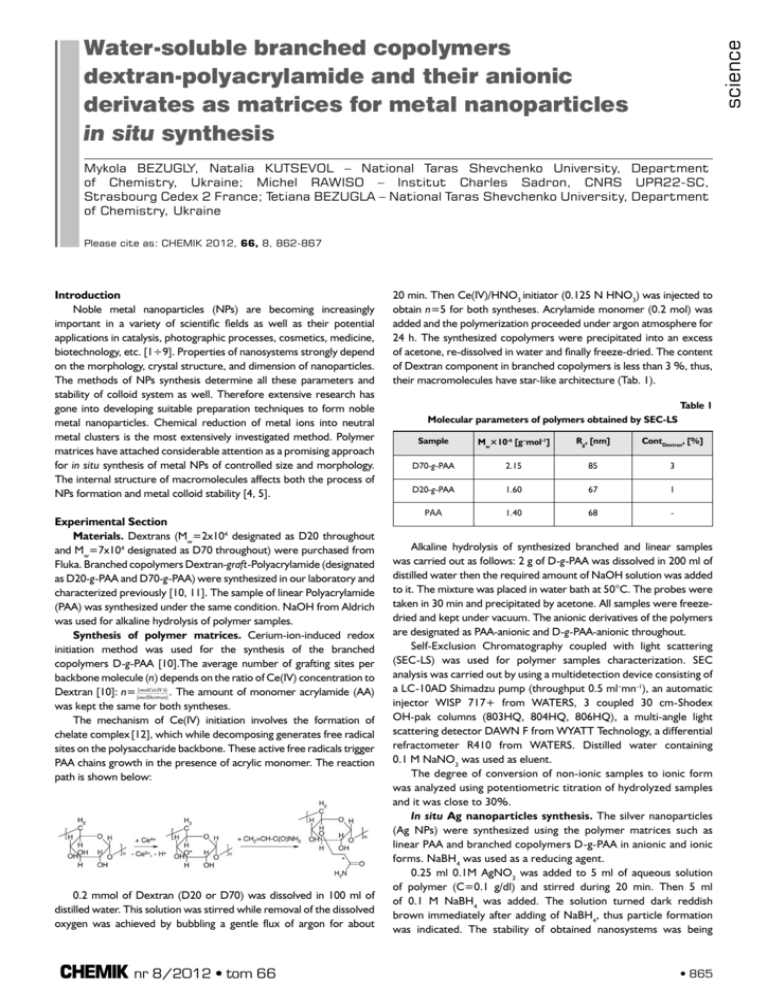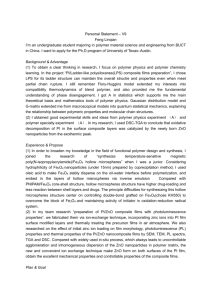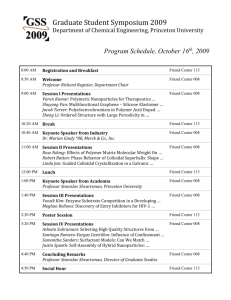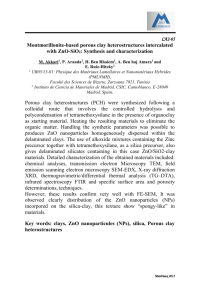Water-soluble branched copolymers dextran
advertisement

science Water-soluble branched copolymers dextran-polyacrylamide and their anionic derivates as matrices for metal nanoparticles in situ synthesis Mykola BEZUGLY, Natalia KUTSEVOL – National Taras Shevchenko University, Department of Chemistry, Ukraine; Michel RAWISO – Institut Charles Sadron, CNRS UPR22-SC, Strasbourg Cedex 2 France; Tetiana BEZUGLA – National Taras Shevchenko University, Department of Chemistry, Ukraine Please cite as: CHEMIK 2012, 66, 8, 862-867 Introduction Noble metal nanoparticles (NPs) are becoming increasingly important in a variety of scientific fields as well as their potential applications in catalysis, photographic processes, cosmetics, medicine, biotechnology, etc. [1÷9]. Properties of nanosystems strongly depend on the morphology, crystal structure, and dimension of nanoparticles. The methods of NPs synthesis determine all these parameters and stability of colloid system as well. Therefore extensive research has gone into developing suitable preparation techniques to form noble metal nanoparticles. Chemical reduction of metal ions into neutral metal clusters is the most extensively investigated method. Polymer matrices have attached considerable attention as a promising approach for in situ synthesis of metal NPs of controlled size and morphology. The internal structure of macromolecules affects both the process of NPs formation and metal colloid stability [4, 5]. Experimental Section Materials. Dextrans (Mw=2x104 designated as D20 throughout and Mw=7x104 designated as D70 throughout) were purchased from Fluka. Branched copolymers Dextran-graft-Polyacrylamide (designated as D20-g-PAA and D70-g-PAA) were synthesized in our laboratory and characterized previously [10, 11]. The sample of linear Polyacrylamide (PAA) was synthesized under the same condition. NaOH from Aldrich was used for alkaline hydrolysis of polymer samples. Synthesis of polymer matrices. Cerium-ion-induced redox initiation method was used for the synthesis of the branched copolymers D-g-PAA [10].The average number of grafting sites per backbone molecule (n) depends on the ratio of Ce(IV) concentration to Dextran [10]: n= . The amount of monomer acrylamide (AA) was kept the same for both syntheses. The mechanism of Ce(IV) initiation involves the formation of chelate complex [12], which while decomposing generates free radical sites on the polysaccharide backbone. These active free radicals trigger PAA chains growth in the presence of acrylic monomer. The reaction path is shown below: 0.2 mmol of Dextran (D20 or D70) was dissolved in 100 ml of distilled water. This solution was stirred while removal of the dissolved oxygen was achieved by bubbling a gentle flux of argon for about nr 8/2012 • tom 66 20 min. Then Ce(IV)/HNO3 initiator (0.125 N HNO3) was injected to obtain n=5 for both syntheses. Acrylamide monomer (0.2 mol) was added and the polymerization proceeded under argon atmosphere for 24 h. The synthesized copolymers were precipitated into an excess of acetone, re-dissolved in water and finally freeze-dried. The content of Dextran component in branched copolymers is less than 3 %, thus, their macromolecules have star-like architecture (Tab. 1). Table 1 Molecular parameters of polymers obtained by SEC-LS Sample Mw×10-6 [g·mol-1] Rg, [nm] ContDextran, [%] D70-g-PAA 2.15 85 3 D20-g-PAA 1.60 67 1 PАА 1.40 68 - Alkaline hydrolysis of synthesized branched and linear samples was carried out as follows: 2 g of D-g-PAA was dissolved in 200 ml of distilled water then the required amount of NaOH solution was added to it. The mixture was placed in water bath at 50°C. The probes were taken in 30 min and precipitated by acetone. All samples were freezedried and kept under vacuum. The anionic derivatives of the polymers are designated as PAA-anionic and D-g-PAA-anionic throughout. Self-Exclusion Chromatography coupled with light scattering (SEC-LS) was used for polymer samples characterization. SEC analysis was carried out by using a multidetection device consisting of a LC-10AD Shimadzu pump (throughput 0.5 ml·mn-1), an automatic injector WISP 717+ from WATERS, 3 coupled 30 cm-Shodex OH-pak columns (803HQ, 804HQ, 806HQ), a multi-angle light scattering detector DAWN F from WYATT Technology, a differential refractometer R410 from WATERS. Distilled water containing 0.1 M NaNO3 was used as eluent. The degree of conversion of non-ionic samples to ionic form was analyzed using potentiometric titration of hydrolyzed samples and it was close to 30%. In situ Ag nanoparticles synthesis. The silver nanoparticles (Ag NPs) were synthesized using the polymer matrices such as linear PAA and branched copolymers D-g-PAA in anionic and ionic forms. NaBH4 was used as a reducing agent. 0.25 ml 0.1M AgNO3 was added to 5 ml of aqueous solution of polymer (C=0.1 g/dl) and stirred during 20 min. Then 5 ml of 0.1 M NaBH4 was added. The solution turned dark reddish brown immediately after adding of NaBH4, thus particle formation was indicated. The stability of obtained nanosystems was being • 865 science controlled during 6 months. Second experiment was carried out using 0.3M AgNO3 and more concentrated polymer solution (C=0.5 g/dl). Absorption spectra were observed in UV-Vis region using Varian Cary 50 Scan UV-Visible Spectrophotometer. Original product solutions were diluted before spectral measurements. The identification of Ag NPs and their size analysis were performed using high-resolution transmission electron microscopy (TEM) and selected area electron diffraction (JEOL (Japan) Jem-1000CXII). Pd nanocatalyst preparation. The palladium nanoparticles (Pd NPs) were synthesized using the polymer matrices of anionic derivatives of linear PAA and branched copolymers D-g-PAA. Polymers solutions were added to aqueous suspension of ZnO and stirred during 2 h. Then solution of palladium chloride was added and stirred during 3 h. The bittern was kept 10 h at room temperature, then filtered, washed and dried. Pd NPs were obtained by chemical reduction of Pd ions into neutral metal clusters using hydrogen as reductant. The heterogeneous catalysts are designated as Pd-PAAanionic/ZnO and Pd-D70-g-PAA-anionic/ZnO throughout. The identification of Pd NPs and their size analysis were performed using high-resolution scanning electron microscopy (JEOL (Japan) JSM-7500). Catalytic activity of synthesized catalysts was studied in the reaction of 3,7,11-threemethyldodecin-1-ol-3 hydration. Results and Discussion In situ synthesis of Ag NPs in polymer matrices resulted in rather stable colloids excepting anionic derivative of PAA. Analysis of microscopy data confirms the obtaining of spherical or roughly spherical Ag NPs with average grain size 20 nm (Fig. 1a) X-Ray diffraction data are in a good agreement with that of face-centeredcubic form of metallic silver (Fig. 1b). a b Fig. 1. (a) TEM and (b) diffraction images of the Ag NPs synthesized in D70-g-PAA matrix The UV-Vis spectrum of silver colloids revealed a surface Plasmon absorption band with a maximum at 400 nm indicating the presence of Ag NPs (Fig. 2, 3). Fig. 2. UV-Vis spectra of Ag NPs synthesized in polymer matrices: 1 – D70-g-PAA, 2 – PAA, 3 – D70-g-PAA-anionic, 4 – PAA-anionic. [AA monomer]/[Ag+]=3 866 • Fig. 3. UV-Vis spectra of Ag NPs synthesized in polymer matrices: 1 – D70-g-PAA, 2 – D20-g-PAA, 3 – PAA, 4 – D70-g-PAA-anionic, 5 – D20-g-PAA-anionic, 6 – PAA-anionic. [AA monomer]/[Ag+]=5 The position and shape of the Plasmon absorption depends on the particles size and shape [2]. As all Ag NPs syntheses were carried out under the same conditions only the nature and structure of polymer matrices affect the particle size and morphology. The analysis of UF-Vis spectroscopy and TEM data shows that for nonionic polymer matrices at lower molar ratio of monomer AA links to Ag+ (Fig. 2) the branched polymer is the most efficient. When molar ratio increases the efficiency of linear and branched polymer matrices becomes close (Fig. 3). For anionic linear and branched polymer matrices the maxima of optical density of Ag colloids are rather lower in comparison with nonionic polymers. In situ synthesis of AgNPs in anionic matrices the formation of a precipitate was observed. The stable colloid system was not obtained in PAA-anionic polymer matrix at [AA monomer]/[Ag+]=3, all Ag particles precipitated. UV-Vis spectrum for Ag NPs obtained in D70-g-PAA-anionic matrix reveals the shift of absorption maximum to short-wave region indicating formation smaller particles in comparison with polymer matrices D20-g-PAA-anionic (Fig. 3). The branched polymers D70-gPAA-anionic and D20-g-PAA-anionic have the same number of grafts, but different distance between them [10, 11]. Thus, the internal structure of branched polymers in solution affects the process of Ag NPs formation. The Ag colloids prepared in the branched polymer matrices were kept at room temperature without precipitate appearance. Linear and branched anionic polymer matrices were also used for preparation of heterogeneous catalysts Pd-PAA-anionic/ZnO and Pd-D70-g-PAA-anionic/ZnO. TEM images display a granular structure of catalyst surfaces, and Pd particles formed in linear and branched polymer matrices have different size (Fig. 4 a,b). Pd particles have size of 2-10 nm and they are fairly evenly distributed on the surface of the media only when using the branched polymer matrix (Fig. 4b). In the case of Pd/ZnO catalyst grains are much larger; some of them have diameter more than 100 nm and form aggregates. a b Fig. 4. TEM images of Pd NPs on catalyst surface: (a) Pd-PAA-anionic/ZnO and (b) Pd-D70-g-PAA-anionic/ZnO nr 8/2012 • tom 66 Conclusions In situ synthesis of Ag NPs in the solutions of linear PAA and branched polymer D-g-PAA resulted in stable Ag colloids. Ag NPs size and morphology were depended on macromolecular structure of polymer matrices. PAA and D-g-PAA anionic derivatives are less efficient in comparison with nonionic polymer matrices for Ag NPs synthesis, but when it is required to use polyelectrolyte matrices the branched samples are preferable. Anionic derivatives of linear PAA and branched D-g-PAA matrices were used for Pd nanocatalyst preparation. The efficient heterogeneous catalysts with nanosized Pd particles distributed on the surface of catalyst carriers were synthesized only when branched polymer matrices were only in branched polymer matrices. Mykola BEZUGLY – PhD, graduated from Faculty of Chemistry, National Taras Shevchenko University (2006). His doctoral thesis (National Taras Shevchenko University) was awarded in 2011. He currently works for National Taras Shevchenko University, Kyiv, Ukraine. Research interests: water soluble branched polymers: synthesis, charaterization. He is the author of 8 articles and the co-author of 23 communications and posters at national and international conferences. E-mail: nikolay_bezugliy@ukr.net, contact telephone number +38 044 239 20 82; Fax: +38 044 239 31 00 Natalia KUTSEVOL – PhD, senior researcher, graduated from Faculty of Chemistry, National Taras Shevchenko University (1983). Her doctoral thesis (National Taras Shevchenko University) was awarded in 2002. She currently works for National Taras Shevchenko University, Kyiv, Ukraine. Research interests: water soluble branched polymers: synthesis, characterization; inter- Acknowledgments This study was funded by Grant NATO CB.NUKR.CLG 98424. The authors are grateful to A. Rameau from Institute Charles Sadron, Strasbourg, France for SEC analysis, A. Kotko from Frantsevich Institute for Problems of Materials Science, Kiev, Ukraine for TEM experiments and A. Zharmagambetova from D. Sokolovsky Institute of Electrochemistry, Almati, Kazakhstan for experiments on catalysis. and intramolecular polycomplexes. Number of papers in refereed journals: 42; number of communications to scientific meetings: 72. E-mail: kutsevol@ukr.net, contact telephone number +38 044 239 20 82; Fax: +38 044 239 31 00 Literature 1. Krutyakov Yu.A., Kudrinskiy A.A., Olenin A.Yu., Lisichkin G.V.: Synthesis and properties of silver nanoparticles: advances and prospects. Russ. Chem. Rev. 2008, 77, 233-257. 2. Nair L.S., Laurencin C.T.: Silver Nanoparticles: Synthesis and Therapeutic Applications. J. Biomed. Nanotechnol. 2007, 3, 301-316. 3. Fabrega J., Luoma S.N., Tyler C.R., Galloway T.S., Lead J.R.: Silver nanoparticles: behaviour and effects in the aquatic environment. Enviromental International 2011, 37, 517-531. 4. Panyala N.R., Pena-Mendez E.M., Havel J.J.: Silver or silver nanoparticles: a hazardous threat to the environment and human health? Appl. Biomed. 2008, 6, 117-129. 5. Lu Y., Spyra P., Mei Yu, Ballauff M., Pich A.: In Situ Formation of Ag Nanoparticles in Spherical Polyacrylic Acid Brushes by UV Irradiation. Macromol. Chem. Phys. 2007, 208, 254-259. 6. Sokolskii D.V., Anisimova N.V., Zharmagambetova A.K., Mukhamedzhanova S.G., Edygenova L.N.: Poly(vinylpyridine) complexes of palladium as hydrogenation catalysts. Effect of polymeric ligand structure. Reaction Kinetics and Catalysis Letters 1987, 33, 387-392. 7. Sharma G., Mei Y., Lu Y., Ballauf M., Irrgang T., Proch S., Kempe R.: Spherical Polyelectrolyte brushes as carriers for platinum nanoparticles in heterogeneous hydrogenation reactions. Journal of Catalysis 2007, 246, 10-14. 8. Mundagri R.C., Patil S.A., Aminabhavi T.M.: Evaluation of acrylamide-graftedxanthan copolymer matrix tablets for oral controlled delivery of antihypertensive drugs. Carbohydrate Polymers 2007, 69, 130-141. 9. Daniel M.-C., Astruc D.: Gold Nanoparticles: Assembly, Supramolecular Chemistry, Quantum-Size-Related Properties, and Applications towards Biology, Catalysis, and Nanotechnology. Chem. Rev. 2004, 104, 293-346. 10. Kutsevol N., Guenet J.-M., Melnik N., Sarazin D., Rochas C.: Solution properties of dextran-poyacrylamide graft copolymers. Polymer 2006, 47, 2061-2068. 11. Kutsevol N., Bezuglyi M., Melnyk N.: Light scattering and viscometry study of star-like dextran graft-polyacrylamide. Chem. and Chem. Techn. 2009, 4, 263-268. 12. Pottenger C.R., Johnson D.C.: Mechanism of cerium (IV) oxidation of glucose and cellulose. J. Polym. Sci. 1970, 3 (2), 301-318. nr 8/2012 • tom 66 Michel RAWISO – DrSc, research director at CNRS, Institut Charles Sadron, Strasbourg, Frace. 1979 – PhD thesis, Université Pierre et Marie Curie (Paris 6), 1987 – State thesis Université Louis Pasteur de Strasbourg. Research interests: Physics of polymers and mixed systems; radiation scattering methods applied to soft condensed matter; polyelectrolytes and multicharged systems. Number of papers in refereed journals: 44 publications; number of communications to scientific meetings: 15 invited lectures; 49 oral communications among which 31 to international meetings; 28 posters among which 22 to international meetings; 24 seminars. E-mail: michel.rawiso@ics-cnrs.unistra.fr contact telephone number 33(03) 88 41 40 94; Fax: 33 (0)3 88 41 40 99 Tetiana BEZUGLA – PhD, senior researcher, graduated from Faculty of Chemistry, National Taras Shevchenko University (1978). Her doctoral thesis (National Taras Shevchenko University) was awarded in 2000. She currently works for National Taras Shevchenko University, Kyiv, Ukraine. Research interests: physical chemistry of polymers and colloids, influence of polymer structure on the solution properties. She is the author of 34 articles in scientific journals and co-author of 65 communications and posters at national and international conferences. E-mail: 2006bezugla@ukr.net, contact telephone number +38 044 239 20 82; Fax: +38 044 239 31 00 • 867 science The heterogeneous Pd catalysts synthesized in branched polymer matrices Pd-D20-g-PAA-anionic/ZnO and linear Pd-D70-g-PAAanionic/ZnO one were considerably more active in the reaction of 3,7,11-threemethyldodecin-1-ol-3 hydration than the catalyst Pd-PAAanionic/ZnO. The catalysts prepared in branched matrices provide the rate of hydration 7 times higher in comparison with catalyst synthesized in linear PAA.









